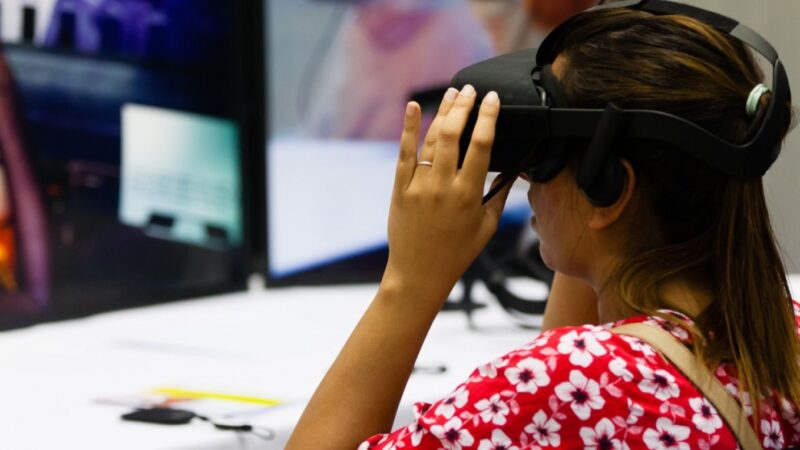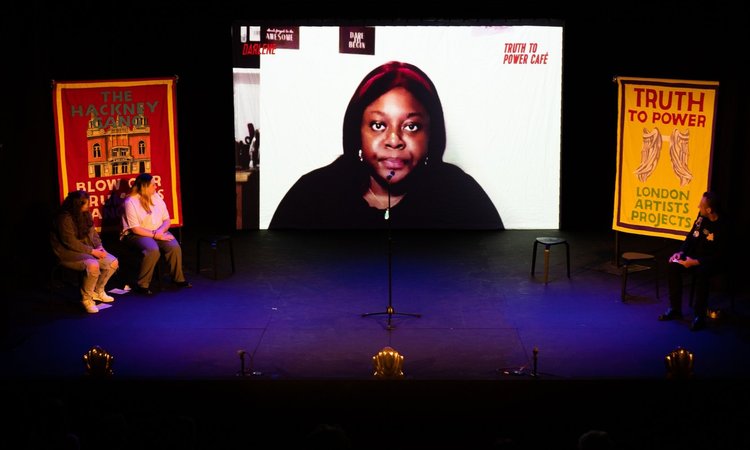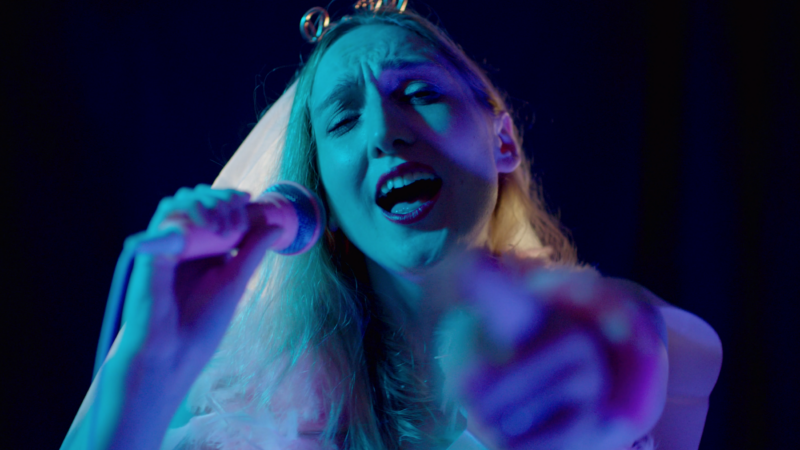Libby Heaney is an artist whose practice includes moving image works, performances, and participatory and interactive experiences. She’s also one of only a handful of artists working with the possibilities created by quantum computing. We asked her to explain how this new technology can be used to inspire, provoke and create art.
What is quantum computing?
Quantum computing is being intensely pursued by companies such as Google, IBM and Microsoft. In 2014, the UK was the first country to announce a quantum strategy, with an investment of £270m. And in 2018, the US followed suit with a $1.2 billion (£851m) investment in quantum information processing over a decade.
So what exactly is this technology? Quantum computers rely on the most basic components of our universe: atoms, electrons, photons (particles of light) exhibiting quantum effects such as superposition and entanglement (see my glossary below for more information on these terms). Quantum superposition is used to create quantum bits, where instead of the binary 0 or 1, a quantum bit (or qubit) can be in many different combinations of 0 and 1 at the same time. This leads to a type of parallel computation where many different calculations run at once rather than sequentially, like on digital computers.
When quantum computing is fully developed it will explode the possibilities of artificial intelligence and, by extension, computational modes of surveillance and control. Quantum computers will be able to run programs in a few minutes which would take the best digital computers 10,000 years to do. They will undoubtedly change the world.
Take the case of search, for instance, which underpins most of the internet today. Current search engines use indexing to make searching efficient. Without this indexing, efficient search (i.e. within a reasonable time) would be impossible. Quantum computers will change all of this and enable efficient search over any unindexed, unsorted databases. This data could include intensely personal information: quantum computers could search according to our emotional states or sexual or political orientation, enabling greater personalisation of targeted advertising or worse. (It’s worth noting that this type of emotional inference is currently predicted by proxy from the personal data we give to social media networks and search engines.)
It is difficult to say when quantum computers will become large enough to run these programs. Because quantum computers function very differently compared to digital computers, they are very difficult to build.
The difficulty comes from noise that destroys quantum superpositions – even a tiny disturbance can cause the plurality of qubits (the quantum equivalent of the binary bit) to revert back to binary. It is very hard to scale up quantum computers and maintain the parallelization of calculations required. This relatively slow development gives humanity time to assess the risks, potentials and impacts of this powerful new technology.
Programming the weird
Quantum computing can give artists a completely new way of seeing and sensing the world. It offers a framework to move away from the binary of digital technology and embrace plurality, through concepts like entanglement.
In my art practice, I work with quantum computing systems. I’m not particularly interested in the fact that quantum computers run certain algorithms quicker. Rather, I’m interested in revealing the non-binary-ness and entangled-nature of the quantum world. When working directly with quantum computers one is able to programme the weird.
The plurality and non-binary-ness of quantum computing intersects with current concerns in contemporary art. One of my favourite authors, Karen Barad, speaks about quantum physics in relation to post-humanism, ecologies and responsibility. I’ve been experimenting with quantum computers as a material basis for actualising her ideas, enabling a queer reinterpretation of images, spaces and bodies. When quantum computers are fully developed, they will see and predict things that we cannot even imagine.
How are artists currently using quantum computing?
The world of quantum computing is still incredibly new, but there are a handful of artists experimenting with the possibilities it offers.
In my own work, I used quantum computing algorithms in a work called ‘Figures in Limbo’. For the piece I re-conceptualised representations of the body from western art history as multiple, boundary-less and form-less. The work thereby disrupts some of the biases around which bodies are represented in art and which are not. I’m also working towards a major exhibition using quantum computing systems that will take place early in 2022 in Berlin with Light Art Space.
Elsewhere, Canadian artist Erin Gee is currently in residence at the Quantum Institute of the Université de Sherbrooke where she’s exploring the possibilities of quantum physics for work in new media and sound: “Quantum physics is a thrilling new challenge for me, because the behaviors and logics of the quantum scale totally contradict things that we take for granted in the world of classical physics that we inhabit from a human perspective.” You can find out more about her work here. I also started working with Erin recently on a collaboration on quantum voices, funded by the British Council and Canada Council for the Arts (there’s more information here).
There’s also interesting work being created by staffers at IBM and other technology companies. For example, Russell Huffmann – a product designer at IBM – blogs about his experiments, which range from creating Mark Rothko-inspired images to visualizing text using data from a quantum computer.
In the world of music, meanwhile, the 1st International Symposium on Quantum Computing and Musical Creativity will be taking place online this November, organised by the University of Plymouth’s Interdisciplinary Centre for Computer Music Research, Cambridge Quantum Computer and IBM Quantum.
Beyond Artificial Intelligence
While quantum computing is still in its early days, it’s useful to look at the parallels with another, closely connected area of technology: artificial intelligence (AI).
Over the last five years, artists such as Pierre Huyghe, Jake Elwes and many others have adopted artificial intelligence (AI) as a medium, object of criticism, or a ‘collaborator’ (although I see neural networks and AI as tools, rather than collaborators).
While neural networks and AI have been around since the ‘50s, their impact on the western world has been increasingly felt over the last decade. These algorithmic systems are eroding our agency and autonomy in the pursuit of guaranteed financial outcomes for advertisers and the giant tech companies.
These rigid systems are rigged with historical and cultural biases disproportionately affecting poor people and people of colour. Poorer people have more data collected about them and are more visible to computational systems than the middle classes who can afford private services. Artists such as Stephanie Dinkins, Hito Steryl, Trevor Paglan and others, including myself, have responded to these injustices in a number of ways and have proposed alternatives.
There are ethical lessons that can be learned for quantum computing from the moral issues thrown up by the incredibly fast development of AI. Now is the perfect time for artists to sit up and take notice of quantum computing, before systems become rigid and difficult to change.
What are the ethical concerns around quantum computing?
While these developments are exciting, it is worrying that the power of quantum computing is concentrated largely in the hands of the big technology companies and opaque start ups. Given the immense resources and skills needed to develop and build quantum computers, it is hard for competitors to enter the field. For example, many prominent quantum scientists have moved from academia to business over the last five to ten years, moving resources from public to private organisations.
The fact that big tech companies have track records with AI that align with surveillance capitalism, dubious ethics and other biased applications suggests that quantum computing might also be applied in this way. The Quantum Daily published a call for action video in February this year where Ilyas Khan the CEO of Cambridge Quantum Computing said there was “a clear and present danger” from quantum computers and there should be a “democratisation of access to benefits” from them. This is a step in the right direction.
What does the future hold?
All of this is precisely why people from outside quantum computing should join the discussions now. That includes people working in and around the arts and humanities. While I don’t want to instrumentalise art, we are able to speculate and create meaning in a richer, freer, more emotive way compared to scientists. While some scientists see art as something ‘nice, but not serious’, and may believe the arts cannot impact a field like quantum computing, it’s worth noting that artists have driven the recent surge of interest in NFTs (non-fungible tokens: see glossary), and driven the discussion around carbon dioxide emissions from blockchain technology.
Whatever your interest in quantum computing, whether you are a scientist, work for a tech company, or are an artist interested in incorporating quantum within your practice, I hope you take this article as a provocation and starting point for further discussion and experimentation around and within this area.
Want to have a go yourself?
- Amazon’s coding language for quantum computers can be found here: https://aws.amazon.com/braket/
- IBM has smaller quantum computers which artists and creatives can access online here: https://www.ibm.com/quantum-computing/
- IBM’s visual tool for quantum programming is here: https://quantum-computing.ibm.com/
- IBM also has some example Jupyter Notebooks here – you’ll need some knowledge of computer coding language Python for these: https://qiskit.org/textbook/ch-prerequisites/python-and-jupyter-notebook…
- Google’s quantum systems are currently proprietary, but you can find out more about the company’s quantum explorations here: https://quantumai.google/
Glossary
- Quantum computing – quantum computing harnesses the quantum physical laws of microscopic objects, such as atoms and photons, to process information using phenomena like superposition and entanglement.
- Qubit – a quantum bit (or qubit) is the quantum equivalent of a binary bit. It is the simplest unit of quantum information. Unlike a bit which can only be in a 0 or 1 state at any instance, a qubit can be in a superposition of 0 and 1 simultaneously.
- Superposition – Superposition is the ability of a quantum system to be in multiple states at the same time until it is measured. For instance an atom may be spinning up and down at the same time.
- Entanglement – is the ability of two or more quantum objects to jointly share properties such that it is impossible to describe each object independently of the other(s).
- Block chain – blockchain is a system of recording information in a way that makes it difficult or impossible to change, hack, or cheat the system. A blockchain is essentially a digital ledger of transactions that is duplicated and distributed across the entire network of computer systems on the blockchain.
- NFTs – Non fungible token (or NFT) is a unit of data stored on a digital ledger, called a blockchain, that certifies a digital asset to be unique and therefore not interchangeable.
- Python – Python is an interpreted high-level general-purpose programming language.
Further reading about quantum computing
- New Scientist and Wired regularly reports on developments in quantum computing.
- MIT’s Technology Review: Quantum computing
- On the more specialised side try The Quantum Daily, Quantum Zeitgeist or Quanta
- The IBM Quantum team publishes a blog documenting their work here
- On Quantum search and how it might work see here
- A talk on quantum computing and art I did for Berlin Science Week about my work at Light Art Space: https://lightartspace.org/programme/libby-heaney
About Libby Heaney
Libby Heaney‘s post-disciplinary art practice includes moving image works, performances and participatory & interactive experiences that span quantum computing, virtual reality, AI and installation.
Heaney’s practice uses humour, surrealism and nonsense to subvert the capitalist appropriation of technology, the endless categoriziations and control of humans and non-humans alike. Instead, Heaney uses tools like machine learning and quantum computing against their ‘proper’ use, to undo biases and to forge new expressions of collective identity and belonging with each other and the world.
How useful was this resource?




